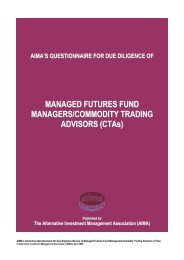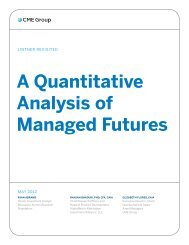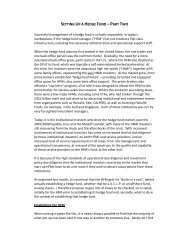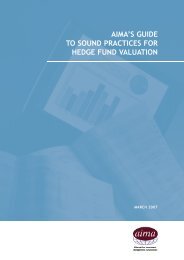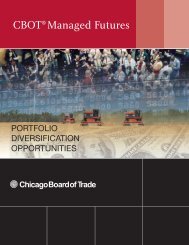Stochastic Volatility and Seasonality in ... - Interconti, Limited
Stochastic Volatility and Seasonality in ... - Interconti, Limited
Stochastic Volatility and Seasonality in ... - Interconti, Limited
Create successful ePaper yourself
Turn your PDF publications into a flip-book with our unique Google optimized e-Paper software.
parameters <strong>in</strong> ψ as well as the variance-covariance matrix Γ of the measurement error terms <strong>in</strong><br />
the measurement equation (22). Follow<strong>in</strong>g Chen <strong>and</strong> Scott (1993), the log-likelihood function<br />
has the follow<strong>in</strong>g form:<br />
l(Y 0 , Y 1 , . . . , Y N ; ψ, Γ) = ∑ [<br />
N<br />
∣<br />
n=1<br />
log p(X n |X n−1 ) − log<br />
∣<br />
∣ ∂f (1),n<br />
∂X<br />
− m 2 log(2π) − 1 2 log |Γ| − 1 2 ɛ′ nΓ −1 ɛ n<br />
]<br />
.<br />
The first term on the right-h<strong>and</strong> side of (24) is the log-likelihood value of the implied statevariables<br />
as filtered through the relationship <strong>in</strong> (23), <strong>and</strong> p(X n |X n−1 ), n = 1, . . . , N, denote<br />
the relevant conditional densities of the Markovian discrete-time solution to the stochastic<br />
differential equation system (1), (2), <strong>and</strong> (3) which describes the transition equation. 9<br />
second term on the right-h<strong>and</strong> side of (24) is the Jacobian determ<strong>in</strong>ant of the transformation<br />
between the observed contract prices <strong>in</strong> Y (1),n <strong>and</strong> X n . The last terms on the right-h<strong>and</strong> side<br />
of (24) are the likelihood of the normally distributed measurement errors.<br />
The estimation results obta<strong>in</strong>ed <strong>in</strong> the follow<strong>in</strong>g analysis is obta<strong>in</strong>ed by numerical maximization<br />
of the log-likelihood function <strong>in</strong> (24).<br />
(24)<br />
The<br />
However, s<strong>in</strong>ce the conditional densities<br />
p(X n |X n−1 ), n = 1, . . . , N, are not known <strong>in</strong> closed-form analytical form, we have chosen<br />
to rely on a quasi maximum likelihood approach where these conditional densities are substituted<br />
by densities from the three-dimensional normal distribution; the appropriate first- <strong>and</strong><br />
second order moments follow from Lemma 1, as stated <strong>and</strong> proved <strong>in</strong> the appendix. Likewise,<br />
<strong>in</strong> our calculation of st<strong>and</strong>ard errors on parameter estimates, we follow the general quasi maximum<br />
likelihood approach suggested orig<strong>in</strong>ally by White (1982); see also e.g. Hamilton (1994),<br />
pp. 126,145.<br />
The concrete implementation <strong>and</strong> optimization <strong>in</strong>volves many numerical considerations<br />
<strong>and</strong>, therefore, we have allocated the follow<strong>in</strong>g subsection to this issue.<br />
However, at this<br />
po<strong>in</strong>t it can be noted that the variance-covariance matrix of the measurement errors, Γ, can<br />
be concentrated out of the log-likelihood function.<br />
From the first order conditions of the<br />
maximization of (24), it is thus seen that the estimator of Γ (for a given set of parameters ψ)<br />
has the form<br />
ˆΓ = 1 N<br />
N∑<br />
ɛ n ɛ ′ n = 1 N<br />
n=1<br />
N∑ (<br />
Y(2),n − f (2),n (X n ) ) ( Y (2),n − f (2),n (X n ) ) ′<br />
n=1<br />
(25)<br />
9 Note that the <strong>in</strong>volved stochastic differential equation system is <strong>in</strong>homogeneous due to the seasonality<br />
feature of the model, though, the time-dependence of the relevant conditional densities is suppressed <strong>in</strong> (24).<br />
10


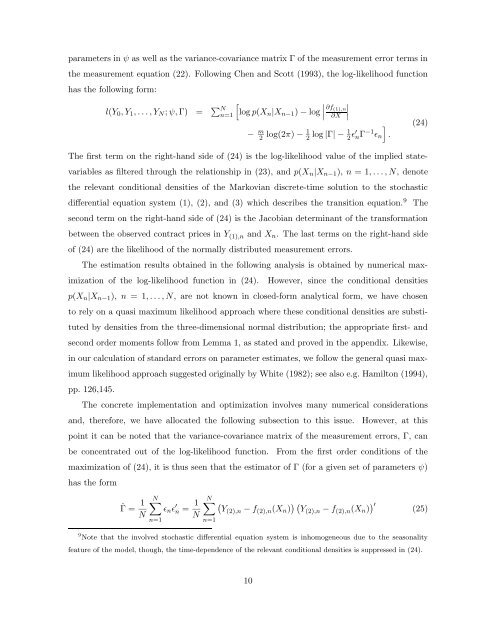
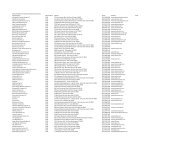
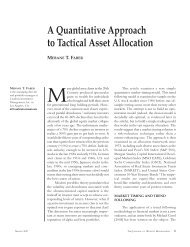
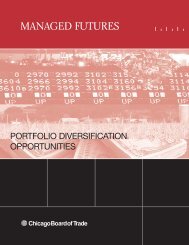

![Definitions & Concepts... [PDF] - Cycles Research Institute](https://img.yumpu.com/26387731/1/190x245/definitions-concepts-pdf-cycles-research-institute.jpg?quality=85)
